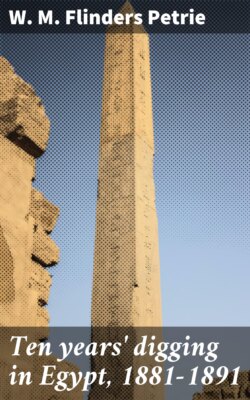Читать книгу Ten years' digging in Egypt, 1881-1891 - W. M. Flinders Petrie - Страница 3
На сайте Литреса книга снята с продажи.
ОглавлениеPREFACE
Table of Contents
Although the discoveries which are related in this volume have been already published, yet there is to be considered the large number of readers who feed in the intermediate regions between the arid highlands and mountain ascents of scientific memoirs, and the lush—not to say rank—marsh-meadows of the novel and literature of amusement.
Those, then, who wish to grasp the substance of the results, without the precision of the details, are the public for whom this is written; and I trust that, out of consideration for their feelings, hardly a single measurement or rigid statement can be found here from cover to cover. Any one who wants detail can find it in the various annual volumes which have already appeared. Several of the finest objects found appear here, however, for the first time in illustration; for having been kept in Egypt I only had photographs to work from, which were, as yet, unused.
The work described here is not by any means all that has occupied my time in these years; much exploring has also been done, and dozens of ancient towns have been visited, and their remains examined; but such work is rather a basis for further results than a source of interest in itself to the public. Besides this I have been occupied in Palestine.
I may as well remark that the first two years’ work were done entirely as a private matter; though the Royal Society afterwards made a grant to cover the greater part of the cost of its publication. The three following years’ work was carried on for the Egypt Exploration Fund; but as the management of that society was not what I had expected, I preferred to withdraw, without personal unpleasantness; in fact, some promoters of it have been more my friends since then than they were before. For a year I rather explored than excavated, having indeed no prospect of funds at my disposal for the purpose. But to my surprise, two supporters of the subject appeared independently, Mr. Jesse Haworth, and then Mr. Martyn Kennard; all expenses of excavation and transport in the last four years’ work, have been at their charge; and the objects found, and not kept for the Egyptian Museum, or retained for private friends, have been presented by them to various public collections. Thus three years have been private work, three years with the Fund, and four years with other friends.
One of the pleasantest results of my work has been the number of co-operators who have appeared, and the friendships that have resulted. In fact an informal body of workers have come together, all attracted by a real love of work, and not by publicity or the buttering and log-rolling of societies. Without any parade of empty names, or speechifying, we each know where to turn for co-operation, and how to join hands to help in the work.
To many the interest of these researches will be the solidity and reality which they give to what we only knew as yet on paper. When we read of ‘Pharaoh’s house in Tahpanhes,’ and then see Defenneh explaining the narrative—when Ezekiel wrote of Javan being ‘merchants,’ and ‘going to and fro, occupied in the fairs’ of Tyre, and we see the widespread trade of the Ionians as early as Gurob—when we read in Homer of the prehistoric civilization, and see the actual products of those races brought to light—we feel how real was the life of which the outlines have come down to us across the ages.
I hope that among my readers there may be some who are not of the superficial class, for whom the tender-foot directions of guide-books are written, and the luxuries of hotels are provided as attractions; so I have given some hints as to how a traveller may go about in Egypt without the usual routine of coddling, and being led by the nose by a dragoman. If the active tripper is thereby induced to take an active trip in Egypt, and—contrary to the custom of most tourists—subordinate the stomach to the intellect, I shall be very glad to make his acquaintance there.
KINGS AND DYNASTIES NAMED IN THIS VOLUME
Table of Contents
| Dynasty. | Approximate date B.C. | |
| IV. | Seneferu, Khufu, Khafra, Menkaura | 4000–3800 |
| V. | Ra-kha-nefer, Unas | 3700–3500 |
| VI. | Rameri-Pepi | 3400 |
| XI. | Antef-aa II, Mentuhotep IV, Antef V, Sankhkara | 2800 |
| XII. | Amenemhat I, II, Usertesen II, III, Amenemhat III | 2700–2500 |
| XIV. | Nehesi-Ra | 2300 |
| XVI. | Apepi | 1900 |
| XVIII. | Tahutmes III, Amenhotep III, IV, Khuenaten | 1450–1350 |
| XIX. | Ramessu II, Merenptah I | 1250–1150 |
| XX. | Ramessu III | 1100 |
| XXII. | Usarkon I | 950 |
| XXV. | Tirhaka, Amenardus | 700 |
| XXVI. | Psamtik (Psammetikhos) I, II; Uahabra (Apries); Aahmes II (Amasis) | 666–526 |
| Ptolemaic. Ptolemy II (Philadelphos) | 286–247 | |
| Roman period | 30 B.C.−400 A.D. | |
| Coptic period | about 400–700 A.D. | |
| Cufic period | about 700–1000 A.D. | |
| Arabic period | 1000 A.D. to present | |
| (The last terms are used vaguely for general indications.) |
